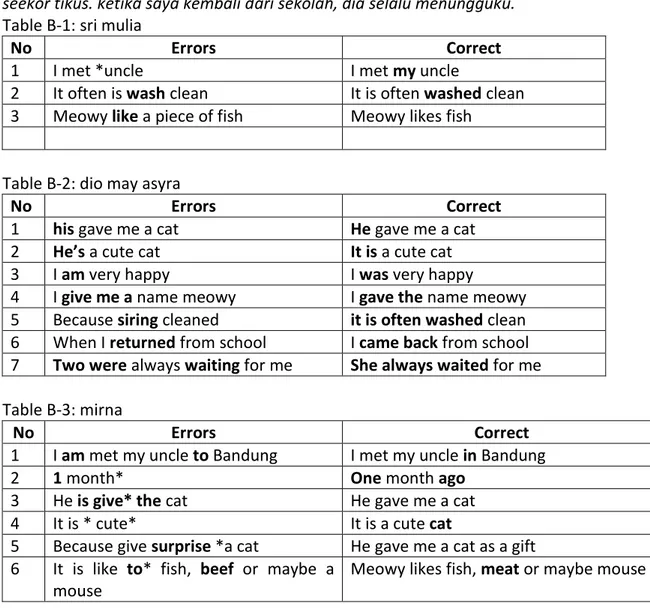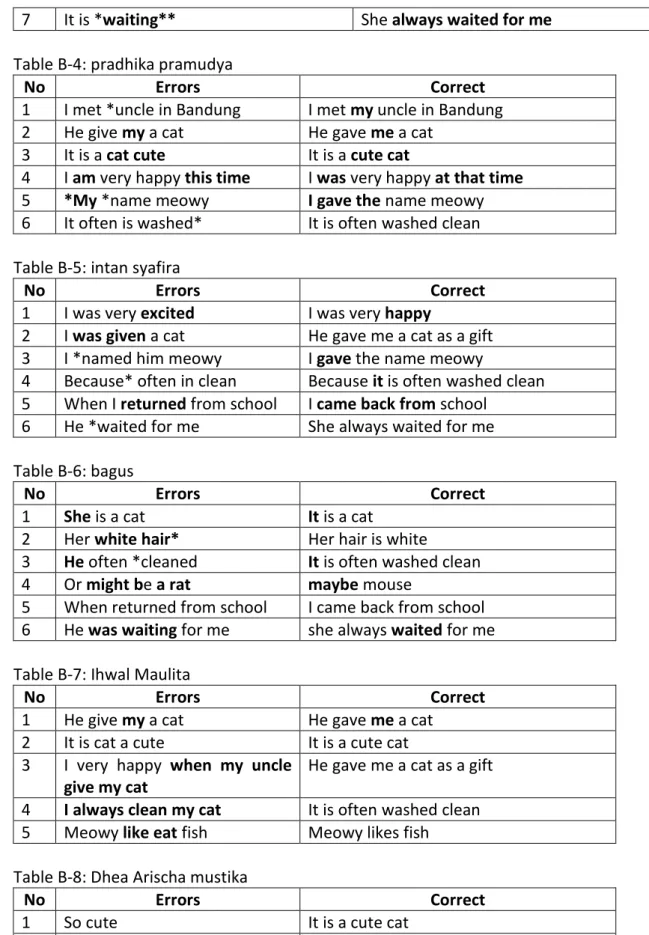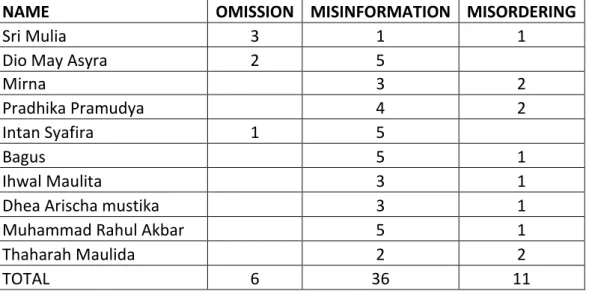Error Analysis of Subject-Verb Agreement
Made by Students in Meurandeh Langsa
Rasyid Gunawan
1, Reni Lestari
2,
Putri Mulyani
3 1,2,3English Department, Samudra University, Langsa, Aceh, Indonesia
e-mail: Renyjestari011@gmail.com
Received: 25 July 2018 Accepted: 27 November 2018
Abstract
This research aimed at identifying the subject-verb agreement errors in students’ writing. This research applied a descriptive research. The data were collected through test and non-test instruments. Test instruments were conducted through writing test and non-test instruments were through questionnaire and interview. The data obtained from both test and non-test instruments were conducted by employing descriptive analysis. This research analyzed students’ narrative writing based on Surface Strategy Taxonomy proposed by Dulay, Burt and Krashen (1982). This result revealed the types of error in subject-verb agreement in the students’ narrative writing covering omission, addition and misinformation. In conclusion, the students involved in the research made a number of errors. It was found that the students’ ability to use subject-verb agreement in English was still low.
Keywords: narrative writing, agreement, omission, addition, misinformation.
1.
Introduction
Language skill consists of four aspects: listening, speaking, reading and writing. The last skill (writing) comes at the end of one’s mastery over the other three skills. Writing is not an inborn skill. It must be learned and practiced in a formal instructional setting. This skill needs the learner to generate ideas and transfer them into text. The gravity of difficulty goes up, because a learner has to consider the grammar, writing convention of the target language and the like of the target language systems. Thus, grammar is a significant aspect of language that a learner has to develop and master among all other aspects of language. Grammar is a set of language rules governing the sounds, words, sentences, and other elements. In a restricted sense, grammar refers only to the study sentence and word structure (syntax and morphology), excluding lexical and pronunciation. The grammar of English, which is a foreign language for most Indonesians, deserves more focused attention. It can be assumed that Indonesian learners of English must have difficulties in learning English grammar. They must have committed errors in the way of developing competence in EFL.
from ambiguity. This requirement is in accordance with their level of education. They are required to do so because as university students, they are exposed with so many academic works to complete.
This research was on subject verb agreement. The Researchers made questionnaires and descriptive paragraph related to subject verb agreement. To this matter, questions were formulated as follow:
a. What kinds of subject-verb agreement errors were mostly made by the students in
writing paragraph?
b. What types of error did they make in their descriptive writings concerning the subject
verb agreement?
2.
Literature Review
2.1 Error
Error is the systematic deviations done by learners who have not mastered the rules of the target language. It happens repeatedly as an unconscious process. Errors are systematic and predictable (Ellis, 1995: 26). Errors reflect a lack of underlying competence in the language they learn. Unlike error, mistake is related to language performance. The learners have known the correct rules, but they are unable to perform their competence. Mistakes can be caused by slip of the tongue and physical condition, such as fatigue, lack of attention, and strong emotion. An example of a mistake is the slip of the tongue done by someone when he wants to say mood but he wrongly utters the word moon.
However, errors are the part of natural process in learning a language (Harmer, 2007) and play a crucial role for the learners to uncover the rules of target language by the feedback they get on the errors (Ellis and Barkuizen, 2005).
2.2 Subject Verb Agreement
Every sentence needs agreement grammar. According to Mas’ud, agreement grammar is very important to be learnt if someone wants to understand and use English in written and spoken well (Mas`ud, 1996). It means that agreement grammar is needed in written and spoken English. Agreement grammar will help the reader or listener to understand the clear meaning of sentences.
According to Mas’ud (1996), agreement (concord) is agreement between the subjects with its verb (predicate). Similarly, Leech (2006) states that concord is a relation between two elements such that they match one another in terms of some grammatical feature. It means that agreement is a relation between two elements that should agree to each other, for instance the agreement between the subject and the verb used in a sentence.
From the explanations above, it is clear that subject-verb agreement is the agreement between subject and verb. If the subject is singular, the verb is also singular and if the subject is plural, the verb is plural, too because the meaning of a sentence will be ambiguous without the subject and the verb that agree to each other
2.3Subject Verb Agreement in Simple Present Tense
in the negative or question sentence. In the nominal form the subject is followed by an
adjective, a noun or an adverb and instead of a verb it makes use of the copular verb to be.
2.4 Subject Verb Agreement
According to Eastwood (1994), there is agreement with be, have, and a present-simple
verb. It means that subject-verb agreement of simple past tense is in nominal form.
2.5Subject Verb in Present Perfect Tense
According to Eastwood (1994), there is agreement with be, have, and a present simple
verb. It means that be and have are used in the present perfect tense for nominal and verbal
form.
3.
Methodology
In this research, descriptive research was conducted through analyzing errors of students’ writing. The aim of this research is to describe the reality behind the phenomenon. The participants of this research were students in Langsa. In collecting the data, the researcher used three kinds of data collections: questionnaire, test, and interview. In this research, the main instrument was test. The researcher administered a test to the students to construct some paragraphs which were used as the data to be analyzed descriptively. Therefore, the researcher only constructed the instruction to do the test. Questionnaire was given to the participants in order to look for additional data that can
support the data, which had been found through interview and document. It was needed
because some students could not answer obviously in the interviews. It was written in form of multiple choices. Interview was conducted in conversations with a particular purpose. 10 participants were interviewed to know the condition of the participants. After doing data collection processes, the researcher analyzed the result of the interview and the document by using analytical descriptive method. In other words, the researcher described the data in sequence language through narrative form. The researcher identified students’ errors from the result of the participants’ answer sheets, especially whether the subjects agree to the verbs or not.
4.
Result and Discussion
The results of the questionnaire were presented in the following tables
Table 1
The Student’s Problem on English lesson
NO. STATEMENT OPTIONS FREQUENCY
1 Apakah anda menyukai pelajaran bahasa
inggris?
Ya 4
Kurang Suka 4
Tidak 2
TOTAL 10
means that it is not surprising if they do not really master in using subject-verb agreement in constructing grammatically correct sentences.
Table 2
Students’ Opinion about Subject-Verb Agreement
NO. STATEMENT OPTIONS FREQUENCY
1 Apa anda mengetahui atau memahami
apa itu Subject-verb Agreement?
Paham 4
Kurang Paham 4
Tidak Paham 2
TOTAL 10
Based on the data of students’ opinion about subject-verb agreement, there are 4 students who understand SVG and six students did not know SVG From this information, the researcher concluded that most of the students thought that subject-verb agreement was difficult.
Table 3
The Student Problem on English lesson
NO. STATEMENT OPTIONS FREQUENCY
1 Apa ada kendala atau kesulitan saat
menentukan Subject verb Agreement? Ya 7
Tidak 3
TOTAL 10
Here are the students’ problems on subject-verb agreement; 7 students had problems and 3 students had no problems on subject-verb agreement. Based on this information, the researcher concluded that most students still got difficulty in using subject-verb agreement.
Table 4
Students’ Opinion about Subject-Verb Agreement
NO. STATEMENT OPTIONS FREQUENCY
1 Menurut anda penting atau tidak anda
mempelajari Subject Verb agreement?
Sangat Penting 2
Penting 7
Tidak Penting 1
TOTAL 10
Students’ response on how important to learn subject-verb agreement was; 2 students assumed that it is very important, 7 students thought that it is important and 1 student said that it is not important. Based on this information, the researcher concluded that most of the students thought that learning subject-verb agreement is very important.
Table 5
Students’ Opinion about Subject-Verb Agreement
NO. STATEMENT OPTIONS FREQUENCY
1 Solusi Seperti apa yang anda lakukan
ketika mendapatkan kesulitan dalam menentukan Subject verb agreement?
Bertanya pada Teman 4
Belajar lagi 2
Total 10
Table 5 indicates students’ alternative if they faced difficulties in learning subject verb agreement; 4 students asked teachers; 4 students asked friends; 2 students learnt about subject verb agreement again. Based on this information, the researcher concluded that most of the students tried to ask their teachers and friends when they got difficulties in studying subject-verb agreement.
4.1 The example of Student’s Errors
Error Analysis from Informant by Senior high school The example of paragraph test:
The Informant must translate this paragraph into English.
Kucing saya Meowy
Saya bertemu paman saya di Bandung, satu bulan yang lalu, dia memberi saya seekor kucing. dia seekor kucing yang sangat imut, saya sangat senang pada waktu itu. karena diberi hadiah seekor kucing, saya berinamanya meowy, dia sangat lucu. rambutnya putih dan berkelahi, karena sering dibersihkan. Meowy suka sepotong ikan, daging atau mungkin seekor tikus. ketika saya kembali dari sekolah, dia selalu menungguku.
Table B-1: sri mulia
No Errors Correct
1 I met *uncle I met my uncle
2 It often is wash clean It is often washed clean
3 Meowy like a piece of fish Meowy likes fish
Table B-2: dio may asyra
No Errors Correct
1 his gave me a cat He gave me a cat
2 He’s a cute cat It is a cute cat
3 I am very happy I was very happy
4 I giveme a name meowy I gave the name meowy
5 Because siring cleaned it is often washed clean
6 When I returned from school I came back from school
7 Two were always waiting for me She always waited for me
Table B-3: mirna
No Errors Correct
1 I am met my uncle to Bandung I met my uncle in Bandung
2 1 month* One month ago
3 He isgive* the cat He gave me a cat
4 It is * cute* It is a cute cat
5 Because give surprise *a cat He gave me a cat as a gift
6 It is like to* fish, beef or maybe a
mouse
7 It is *waiting** She always waited for me
Table B-4: pradhika pramudya
No Errors Correct
1 I met *uncle in Bandung I met my uncle in Bandung
2 He give my a cat He gave me a cat
3 It is a cat cute It is a cute cat
4 I am very happy this time I was very happy at that time
5 *My *name meowy I gave the name meowy
6 It often is washed* It is often washed clean
Table B-5: intan syafira
No Errors Correct
1 I was very excited I was very happy
2 I was given a cat He gave me a cat as a gift
3 I *named him meowy I gave the name meowy
4 Because* often in clean Because it is often washed clean
5 When I returned from school I came back from school
6 He *waited for me She always waited for me
Table B-6: bagus
No Errors Correct
1 She is a cat It is a cat
2 Her white hair* Her hair is white
3 He often *cleaned It is often washed clean
4 Or might be a rat maybe mouse
5 When returned from school I came back from school
6 He was waiting for me she always waited for me
Table B-7: Ihwal Maulita
No Errors Correct
1 He give my a cat He gave me a cat
2 It is cat a cute It is a cute cat
3 I very happy when my uncle
give my cat
He gave me a cat as a gift
4 I always clean my cat It is often washed clean
5 Meowy like eat fish Meowy likes fish
Table B-8: Dhea Arischa mustika
No Errors Correct
1 So cute It is a cute cat
2 I *very happy when my uncle
give my cat
He gave me a cat as a gift
3 I always clean my cat It isoften washed clean
Table B-9: Muhammad rahul akbar
No Errors Correct
1 She’s a cute cat It is a cute cat
2 I **name meowy I gave the name meowy
3 She is very cute, her *white hair
Very funny, her hair is white
4 He often *cleaned Itis often washed clean
5 Might be a rat Maybe a mouse
6 When I returned from school When I came back from school
Table B-10: Thaharah maulida
No Errors Correct
1 He givemy a cat He gave me a cat
2 It is cat a cute It is a cute cat
3 My **name meowy I gave the name meowy
4 **White hair Her hair is white
Table 11. Summary of the analysis of frequent subject and verb agreement errors made by the student
NAME OMISSION MISINFORMATION MISORDERING
Sri Mulia 3 1 1
Dio May Asyra 2 5
Mirna 3 2
Pradhika Pramudya 4 2
Intan Syafira 1 5
Bagus 5 1
Ihwal Maulita 3 1
Dhea Arischa mustika 3 1
Muhammad Rahul Akbar 5 1
Thaharah Maulida 2 2
TOTAL 6 36 11
Based on the above data, the students in Langsa still faced difficulties in subject-verb agreement. Two reasons were assumed that students still made some mistakes in SVA such as; the students thought that subject-verb agreement material was difficult. As a result, it was not surprising if they did many errors in the aspects of subject-verb agreement. Another reason was because they did not know exactly about the subject-verb agreement rules. They did not know well how to construct correct sentences.
4. Conclusion
when making grammatical sentences. The students are still confused in making an agreement between the subject and the verb. It could happen because in Indonesian language there is no agreement between the subject and the verb. The researcher would like to give some suggestions to students. For the students, they should do more exercises in learning subject-verb agreement and be active to ask the teacher or friends when getting difficulties in learning subject-verb agreement.
The result of this research also found three types of errors experienced by the students namely misinformation, omission and addition. The inter-lingual transfer, intra-lingual transfer, and misleading inputs have caused those errors. In order to overcome the problems, the teacher needs to employ breakthrough strategy/ approach in teaching the students. The activities must enable the students to improve their awareness of subject-verb agreement to write paragraphs in the present tense. It is hoped that by doing this, the students can accelerate their writing so that their English will function well.
References
Brown, H. D. (2000). Principles of Language Learning and Teaching (4th Ed). New York:
Longman.
Dulay, H., Burt. M. & Krashen S. (1982). Language Two. Oxford. UK: Oxford University Press.
Eastwood, John. (1994). Oxford Guide to English. New York: Oxford University Press.
Ellis, R. (1995). Understanding Second Language Acquisition. Oxford: Oxford University Press.
Ellis, R., & Barkhuizen, G. (2005). Analysing Learner Language. Oxford: Oxford University
Press
Greenbaum, Sidney and Gerald Nelson. (2002). An Introduction to English Grammar (2nd
ed). Longman: Pearson Education Limited.
Harmer, Jeremy. (2007). The Practice of English Language Teaching. London: Longman.
Huddleston, Rodney and Geoffrey K. Pullum. (2005). A Students Introduction to English
Grammar. Cambridge: Cambridge University Press.
Leech, Geoffrey. (2006). A Glossary of English Grammar. Edinburgh: Edinburgh University
Press.
Mas’ud, Fuad. (1996). Essentials of English Grammar a Practical Guide (2nd ed). Yogyakarta:
BPFE.
Nayan, S. (2009). A Study of Subject Verb Agreement: From Novice Writer to Expert Writer.
International Education Studies, 2(30, 190-194.
Spaarks, P. S. (2006). Commonsense Grammar and Style: English For Professionals. Boulder,
Co. Westview Publishing Inc.
Sunardi, Hasyim. (2002). Error analysis in the teaching English. KATA: A Biannual Publication



